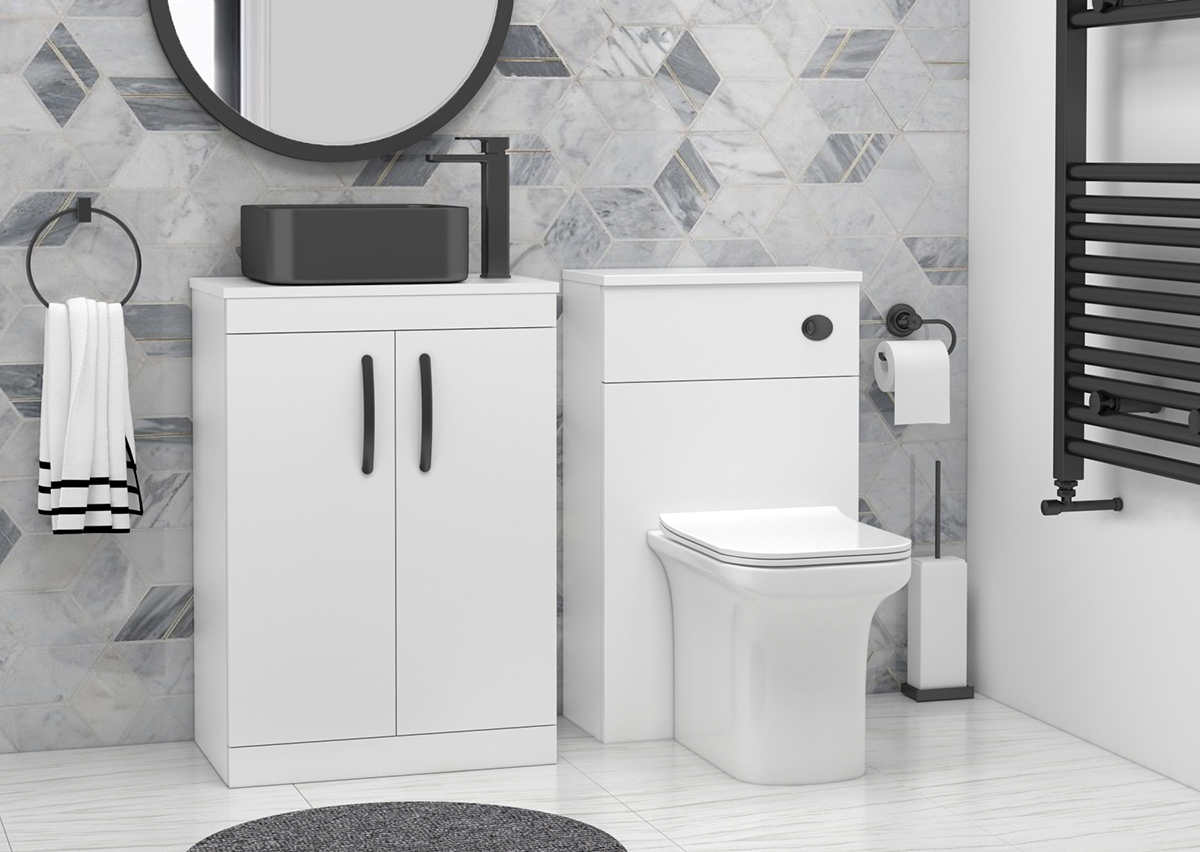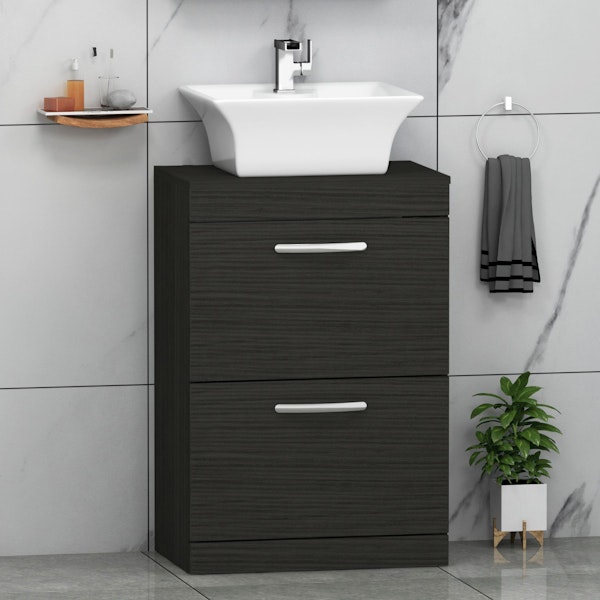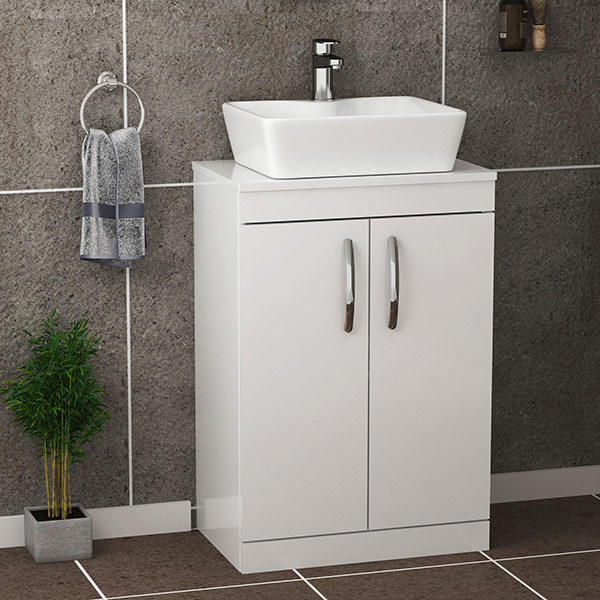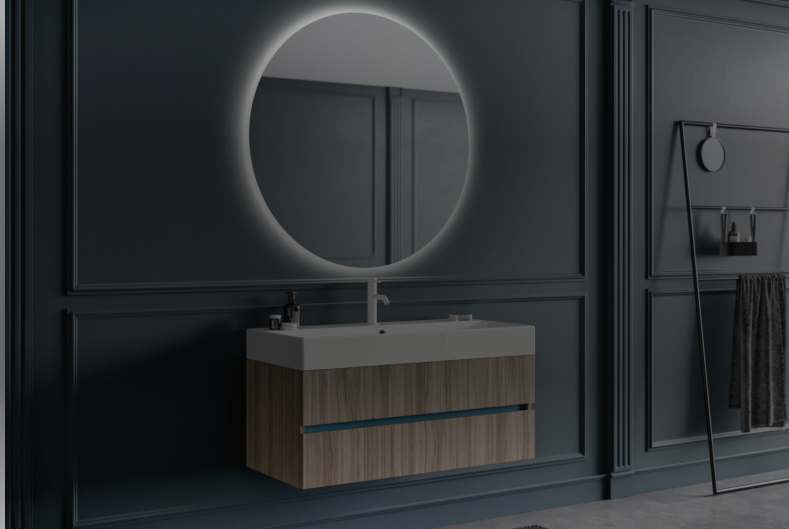
Vanity units have become a must-have in modern bathrooms. This is largely due to the functionality of their storage space, but also their ability to enhance the desired aesthetic of a contemporary bathroom design.
Properly installing freestanding worktop vanity units is crucial to ensure their stability and longevity , whether you choose a floating or a freestanding unit.
While hiring a professional fitter is always a safe bet , those on a budget can consider a DIY installation, provided they have the necessary expertise.
Our comprehensive installation guide offers step by step instructions for a DIY freestanding worktop vanity installation.
Freestanding Worktop Vanity Unit Types
Below are the different types of freestanding bathroom vanity units available at Royal Bathrooms.


1. Turin
Description:
The Turin bathroom vanity unit collection features a minimalist design that saves space whilst oozing style. Available in high gloss, and hale black finishes, it is a popular choice amongst homeowners.
What’s more, it's easy to clean , making it a super practical storage solution.


2. Milan
Description:
The Milan freestanding bathroom vanity unit range features on- trend designs that will add the finishing touch to any modern bathroom.
With a muted matte finish and the choice of two inspiring colors - electric blue and coastal grey, this range brings a touch of luxury to your bathroom, while blending seamlessly with other fittings for a cohesive look.
Pros and Cons of Installing Freestanding Worktop Vanity Units
Freestanding worktop vanity units are becoming popular for ensuites and family bathrooms thanks to their versatile design and improved storage capacity. But like any other fixture, vanities have some downsides.
Let’s uncover the advantages and disadvantages of freestanding vanity:
Pros
- Versatility: Freestanding worktop vanity units can be placed anywhere in the bathroom, making them a great choice for both large and small spaces. The attractive design makes them a focal point of the room, whilst working to complement your bathroom decor.
- Easy installation: Since they do not mount straight to the wall, freestanding worktop units are easy to install. Secondly, they can be easily moved or replaced without risking any damage to the wall.
- Range of Options: They come in many different materials such as wood, glass, and stone, offering you more choice when looking for something that suits your style.
- Storage: Most free standing worktop vanity units come with ample storage space. They can have drawers or cabinets, offering a convenient storage solution for toiletries and other essentials.
Cons
- Cost: Compared to traditional wall-mounted vanities, freestanding worktop units are more expensive due to the extra material needed to make the base.
- Maintenance: Since the base of the vanity directly contacts the floor, it is susceptible to moisture damage.
- Space: Depending on the size of the unit, these vanities can take up a lot of space in the bathroom, making them too large for small bathrooms.


Preparing for Installation
Assessing your Bathroom Space
Assessing the available space in the bathroom is key to installing a new fixture. You need to measure the available space to determine what size of freestanding worktop unit will fit in the room without compromising the free space.
Make sure the vanity does not take up too much space or look too small in relation to the bathroom or respective fixtures. You should also consider the placement of existing fixtures, such as the toilet, shower, and bathtub, and choose a spot that does not obstruct them.
Choosing the Right Unit Size and Material
The size of the unit should be based on the available space in the bathroom, the number of household members, and their storage needs. The material needs to be durable and moisture-resistant to withstand wear and tear over the years.
Popular materials for freestanding vanity units include wood, stone, glass, and metal. It is important to select the vanity that matches the overall design of your bathroom.
Evaluating Storage Needs
The users’ storage needs should also be considered when choosing the freestanding worktop vanity unit. You should determine the number of drawers or shelves required to store toiletries, towels, and other bathroom essentials.
Comparing Turin and Milan Freestanding Worktop Vanity Units
Here we have compared the features of our Turin and Milan ranges to give a quick snapshot of the options. While both ranges come with 4 doors and 4 drawer options, there’s a lot more for you to choose between:


Installation Steps for Freestanding Worktop Vanity Units
Vanity unit installation isn’t as challenging as you might think.
Given the right tools and basic manufacturer’s guidance, you can fix a worktop vanity unit yourself. Nevertheless, if you don’t feel fully confident in tackling the job, always hire a professional contractor.
Step by Step Installation Guide
- Gather the Necessary Tools and Materials: Before starting the installation, make sure you have all the tools and materials needed for the job. This may include a level, drill, screws, plumbing fittings, silicone sealant, and any other necessary hardware.
- Prep the Bathroom Floor: Ensure that the floor is leveled and debris free. If necessary, use a leveling compound or add shims to level the floor.
- Install the Sink and Faucet: If the sink and faucet didn’t come pre-installed in the worktop, attach them according to the manufacturer's instructions. You might need to drill holes in the worktop for the faucet and sink drains.
- Assemble the Freestanding Unit: Follow the manufacturer's instructions while assembling the vanity. This process usually involves attaching legs, drawers, and shelves.
- Position the Unit: Carefully move the freestanding unit into position to its dedicated spot in the bathroom. Use a spirit level to ensure that it is level and stable. If necessary, adjust the leveling feet or add shims to level the unit.
- Secure the Unit to the Floor: Once the unit is in the correct position, secure it to the bathroom floor using screws or brackets. Make sure the screws are securely fastened to prevent the unit from moving or tilting.
- Connect the Plumbing: Connect the sink drain, faucet, and any other necessary plumbing fittings according to the manufacturer's instructions. Use silicone sealant to seal the gaps between the sink and worktop.
- Test the Unit: Once the installation is complete, examine the unit by turning on the water and checking for leaks. If everything is working properly, clean up any debris and enjoy your new freestanding worktop vanity unit!
Tips for Connecting Plumbing Fixtures
- Plan Ahead: Before beginning the installation, plan out the plumbing connections to ensure that everything fits properly and is accurately aligned. Take precise measurements and consider the existing fixtures that may need to be worked around.
- Use the Right Fittings: Use high-quality plumbing fittings that are compatible with your existing plumbing system. This will help prevent leaks and ensure that everything is connected securely.
- Tighten Fittings Properly: Use an adjustable wrench to tighten fittings to the recommended torque specification. Over-tightening can cause damage or leaks, while under-tightening can result in loose connections.
- Use Teflon Tape: Use Teflon tape on threaded fittings to ensure a tight, leak-free seal. Apply the tape in a clockwise direction and wrap it around the threads at least three times.
- Check for Leaks: After connecting the plumbing fixtures, turn on the water and check for leaks. Look for any dripping or pooling water, and tighten the loose fittings, if any.
- Seal the Gaps: Use silicone sealant to seal any gaps between the sink and worktop or between the vanity unit and the wall.
Making Better Decisions with Our Freestanding Worktop Vanity Unit Buying Guide
When it comes to choosing the freestanding bathroom vanity unit, our buying guide offers all the information and guidance you need to make a better decision.
Whether you're looking for a modern, minimalist design or a classic, traditional look, our guide has it all covered for you.
So, if you're looking for expert advice on selecting freestanding worktop vanity units, be sure to refer to our buying guide for more information.


Hiring a Professional vs. DIY Installation for a Freestanding Worktop Vanity Unit
Deciding whether to hire a professional or whether to undertake the vanity unit installation yourself can be a tough call. On the one hand, hiring a professional means you can rest assured that the job will be completed correctly and efficiently. They have the necessary expertise to avoid any costly mistakes that may occur during a DIY project.
Plus, you can enjoy the peace of mind that comes with having a warranty for their work. However, if you are up for a challenge and enjoy tackling home improvement projects, a DIY installation can be a rewarding experience. It allows you to customise the project to your liking and can potentially save you money.
Just be sure to research, gather the right tools and materials, and take the necessary precautions to ensure the installation is safe and successful.
Ultimately, the decision comes down to your comfort level, experience, and the complexity of the installation.
Why Choose Royal Bathrooms for Your Freestanding Worktop Vanity Unit Needs
There are many reasons why our customers trust Royal Bathrooms UK for their freestanding bathroom vanity unit:
- Wide range of vanity units to choose from
- High-quality and durable moist-resistant materials used in construction
- Competitive prices and regular discounts offered
- Fast and free delivery across the UK
- Flexible payment options available, including interest-free credit
- Excellent customer service and support are available via email and phone.
- Hassle-free returns and exchange policy
Conclusion
Installing a freestanding worktop vanity unit can be a great way to update the style and functionality of your bathroom. Whether you decide to hire a professional or tackle the installation as a DIY project, there are many things to consider.
From assessing your space and evaluating your storage needs to choosing the right materials and properly connecting plumbing fixtures, careful planning and attention to detail are key.
So, whether you're looking to update your bathroom for aesthetics or want to add value to your home, a freestanding worktop vanity unit can be a great investment that you'll appreciate for years to com

